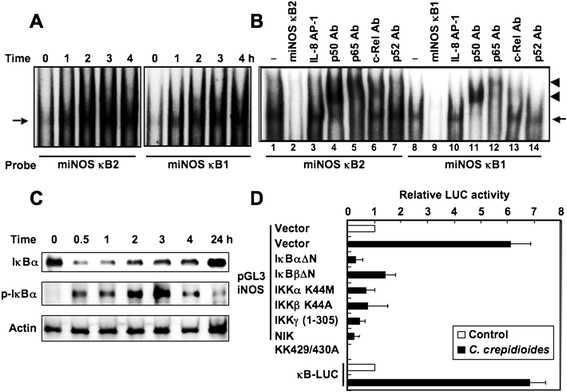Figure 6.

Effects ofC. crepidioideson signal pathway through NF-κB activation. (A) NF-κB1- and NF-κB2-dependent binding of nuclear proteins in RAW264.7 cells. The cells were treated with C. crepidioides (500 μg/ml) for the indicated time periods before preparing nuclear extracts for analysis by EMSA with probe miNOS κB1 or κB2. (B) Sequence specificity of NF-κB binding activity and characterization of proteins that bound to the NF-κB binding sites. Competition assays were performed with nuclear extracts from cells treated with C. crepidioides (500 μg/ml) for 2 h. Excess amounts of competitor (100-fold) were added (lanes 2, 3, 9 and 10). Supershift assay in the same nuclear extracts was also performed. Antibodies (Ab) were added (lanes 4-7 and 11-14). Arrows: specific complexes, arrowheads: supershifted DNA binding complexes. (C) C. crepidioides induces phosphorylation and degradation of IκBα. Cells were treated with C. crepidioides (500 μg/ml) for the indicated time periods and lysates were subjected to immunoblotting. (D) Overexpression of dominant-negative mutants inhibits C. crepidioides-induced activation of the iNOS promoter. Cells were transfected with pGL3 iNOS or κB-LUC and the mutant plasmids and then treated with C. crepidioides (500 μg/ml) for 6 h. Open bar: luciferase activity of pGL3 iNOS and empty vector or κB-LUC alone without treatment. All values were calculated as the change (n-fold) in induction value relative to the basal level measured in untreated cells. LUC, luciferase. Data are mean ± SD of three independent experiments.
